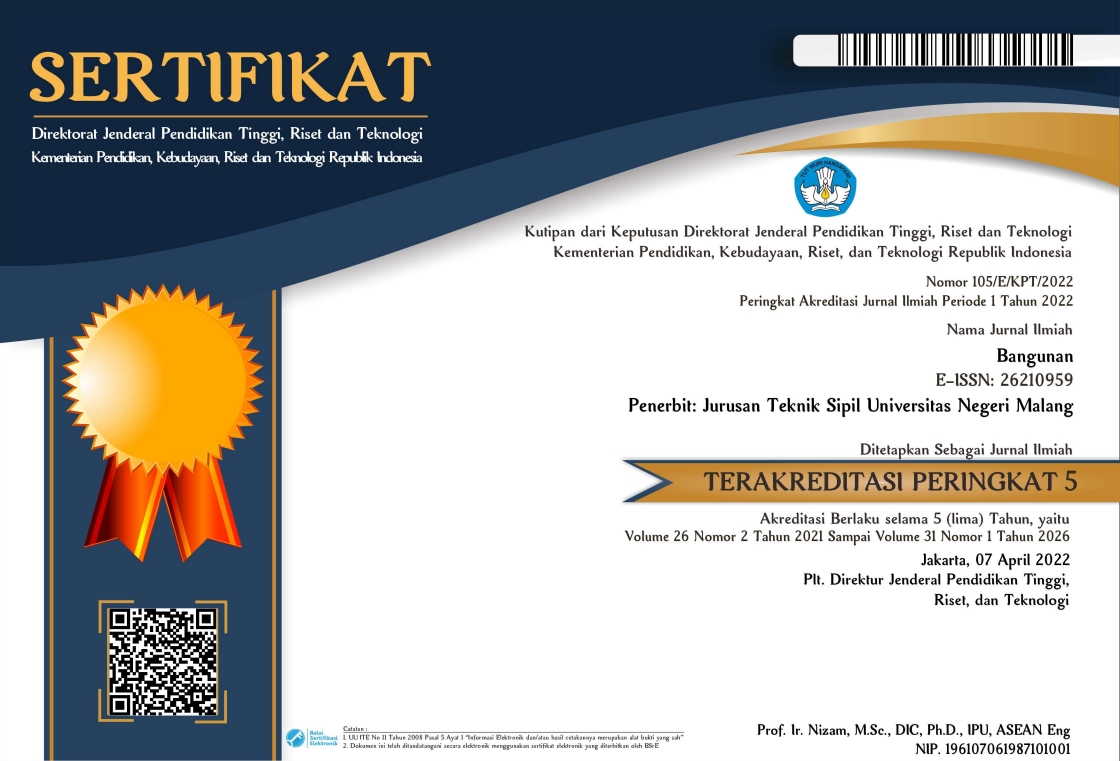ANALISA STABILITAS LERENG DAN ALTERNATIF PERKUATAN TANAH PADA JALUR KERETA API CEPAT JAKARTA-BANDUNG MENGGUNAKAN APLIKASI PLAXIS 8.6
Abstract
Abstrak: Masalah dalam perencanaan struktur jalan kereta seperti tinggi lereng embankment yang lebih dari sama dengan 6 m, tanah asli yang tergolong sedang lunak, dan merupakan daerah rawan terjadinya longsor merupakan alasan dilakukannya penelitian ini. Hal tersebut didukung oleh hasil uji lab tanah, kondisi geografis dan geologis Kabupaten Purwakarta berupa bukit dan lembah yang terbentuk dari endapan batuan sedimen dan aluvium vulkanik dengan kemiringan lahan 8-40%. Oleh karena itu penelitian ini bertujuan untuk mengetahui stabilitas lereng embankment berupa nilai safety factor pada jalur kereta cepat Jakarta-Bandung daerah konstruksi DK70+150.00 sampai DK70+181.88. Adapun analisis numerik yang dilakukan pada penelitian ini menggunakan program Plaxis 8.6 yang dikembangkan berdasarkan metode Finite Element dengan model Mohr-Coulomb. Proses analisis dengan menginput parameter material yang dibutuhkan berdasarkan Mohr-Coulomb. Hasil analisis berupa angka safety factor yang menunjukkan kondisi stabilitas suatu lereng embankment. Penambahan alternatif perkuatan lereng embankment berupa cerucuk (micropile), bronjong (gabion) dan geotextile sebagai upaya pencegahan adanya kelongsoran jangka pendek dan panjang pada lereng embankment yang tidak stabil. Hasil analisis lereng embankment kereta api cepat Jakarta-Bandung DK70+150 sampai DK70+181.88 kondisi eksisting sebesar ΣMSF 1,1565 (cek global) dan ΣMSF 1,0515 (cek dinamik gempa) yang artinya lereng dalam kondisi tidak stabil dan perlu penambahan alternatif perkuatan. Berdasarkan simulasi kombinasi alternatif perkuatan. Menunjukkan kombinasi alternatif perkuatan geotextile dengan micropile menghasilkan angka safety factor ΣMSF 1,8151 (cek stabilitas global) dan ΣMSF 1,6262 (cek stabilitas akibat beban dinamik gempa).
Kata-kata kunci: stabilitas lereng embankment, Plaxis 8.6, safety factor, kereta cepat Jakarta-Bandung
Abstract: Problems in the design of the railway structure such as the embankment slope height of 6 m, the original soil which is classified as moderately soft, and is an area prone to landslides is the reason for conducting this research. This is supported by the results of soil lab tests, geographical and geological conditions of Purwakarta Regency in the form of hills and valleys formed from sedimentary rock deposits and volcanic alluvium with a slope of 8-40%. Therefore, this study aims to determine the stability of the embankment slope in the form of the safety factor value on the Jakarta-Bandung high-speed rail line in the construction area DK70+150.00 to DK70+181.88. The numerical analysis carried out in this study used the Plaxis 8.6 program which was developed based on the Finite Element method with the Mohr-Coulomb model. The analysis process by inputting the required material parameters based on Mohr-Coulomb. The results of the analysis are in the form of safety factor numbers which indicate the stability condition of an embankment slope. The addition of alternative reinforcement for embankment slopes in the form of micropile, gabion (gabion) and geotextile as an effort to prevent short and long term landslides on unstable embankment slopes. The results of the slope analysis of the Jakarta-Bandung high-speed rail embankment DK70+150 to DK70+181.88 existing conditions of MSF: 1.1565 (global check) and MSF: 1.0515 (earthquake dynamics check) which means the slope is in an unstable condition and needs additional alternative reinforcement. Based on the simulation of alternative reinforcement combinations. Showing the alternative combination of geotextile reinforcement with micropile produces a safety factor number MSF: 1.8151 (check global stability) and MSF: 1.6262 (check stability due to dynamic earthquake loads)..
Keywords: embankment slope stability, Plaxis 8.6, safety factor, Jakarta-Bandung high-speed train
Full Text:
PDFDOI: http://dx.doi.org/10.17977/um071v26i12021p29-44
Refbacks
- There are currently no refbacks.

This work is licensed under a Creative Commons Attribution-ShareAlike 4.0 International License.

This work is licensed under a Creative Commons Attribution-ShareAlike 4.0 International License.



